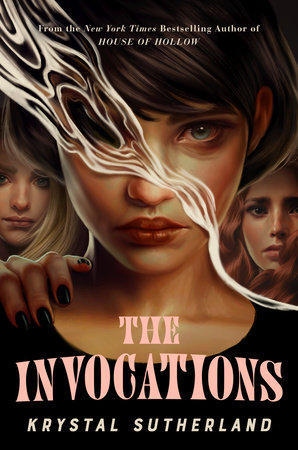The Invocations
- By Krystal Sutherland
- Nancy Paulsen Books
- 400 pp.
- Reviewed by Nick Havey
- February 22, 2024
Teens hunt witch-killers in this fantastical (and fantastic) feminist tale.

On New Year’s Day, I woke up refreshed (having not drunk the night before) and full of energy to spend on the first day of 2024. What did I choose to do? Watch all nine episodes of “The Power.” Based on Naomi Alderman’s 2016 novel of the same name, the series follows women around the world as their bodies develop a latent organ — the skein — that gives them the power to conduct electricity. The skein is initially identified in teens but is later found in older women, too, an evolutionary trait necessary after centuries of violence against women.
The novel and show are clear-cut critiques of patriarchal society and the dangers women endure by virtue of their mere existence. As I read Krystal Sutherland’s The Invocations, I couldn’t help but think how different its England would’ve looked had all its female characters been given access to the power some attain through the ritualistic tattooing of curses — invocations — onto their skin. The thought, like the novel, was electrifying.
While reading The Invocations, I found myself mentally pinning red string across a murder board as I made connections to the book’s clear influences (The Craft, the Bible, Latin, etc.) and what I hoped were clever breadcrumbs for the reader. We start with Emer, a curse-writer perennially on the run after her entire family is slaughtered by witch-hunters. The sole survivor of her coven, she’s hellbent on making sure the men who killed her family pay for their crimes.
From there, the book is a sprint. We quickly meet Jude Wolf and Zara Jones, young women with their own reasons for pursuing the occult. When the three combine their powers, they become an all-girl “Scooby-Doo! Mystery Incorporated,” with Emer as Velma (smart, prepared, and cautious), Jude as Fred (cocky; thinks she’s in charge but is in constant need of saving), and Zara as Daphne (helpful, but mostly as bait). They’ve come together to solve the riddle at the core of their troubles: a serial killer targeting women who have invocations — including Zara’s older sister, who is slain.
Jude and Zara first meet, as girls do, at the scene of a murder whose victim has had an invocation cut from her body. Their mutual friend is a crooked cop who’s financing her divorce with Jude’s trust fund. At a crime scene or two later, Jude and Zara find Emer’s calling card and precursor to an invocation: a leaden script with a spell.
They soon track Emer down, and from there, the trio becomes a merry band of teenage crime-solving, curse-writing, demon-harnessing sleuths. Their adventures take them to the bottom of a lake, where they find the corpse of their primary suspect; on a date with an alleged witch-hunter; and on a tour of an old-boys club that turns out to be the witch-hunter’s headquarters.
At the climax of the novel, Jude attends the wedding of her father, Lawrence, patriarch of her “Succession”-style family. It’s the perfect event at which to resurrect Zara’s sister. With her help, they just might crack the witch-killer case. But their plan to use the family manor’s panic room as a revived-dead-sibling containment zone backfires, and the girls fall into a trap. Zara, however, did “not come this far to only come this far,” so they all band together to fight the now-unmasked killer, who has them cornered as Zara’s bloodthirsty zombie sister rains hell upon the wedding guests.
Sutherland reminds us early on that “translation is an art.” Speaking about the importance of carefully crafted language when yoking a demon to one’s soul, she tells us “it is about conveying a deeper meaning, about painting an image in the demon’s photo-mind, something deep and visceral that it can understand.” Emer’s gift is her control over language. She does the best curse-writing possible, and the demons under her command respect that. Language is important because it translates into power, both within the context of the novel and in the larger society bound by patriarchy. Gender is a construct, and men have weaponized it. Curse-writing is a response to that.
Language is also important to the plot twists whose clues are embedded in the text. Can you solve the story’s mystery rather quickly if you speak Russian? Absolutely! Is a working knowledge of the Bible helpful for figuring out some things about the characters? Also yes! But these are features, not flaws. And even if you finger the killer before he’s unmasked, almost any man would make a plausible culprit:
“A man with everything: wealth, good health, access to education. Still it was not enough for him. Still he felt hard done by. Still he had to take more.”
This is the central idea of the novel, that power — even the mere pursuit of it — corrupts. The book ends with hope for the future (Sutherland is smart to portend a sequel), but it is also cautious. As we have learned here, magic comes at a cost. And for readers, the magic that is The Invocations comes at a horrible cost: the absolutely devastating comedown one experiences after finishing a great book.
Nick Havey is director of Institutional Research at the American Association of Colleges of Nursing, a thriller and mystery writer, and a lover of all fiction. His work has appeared in the Compulsive Reader, Lambda Literary, and a number of peer-reviewed journals.
_80_117.png)
